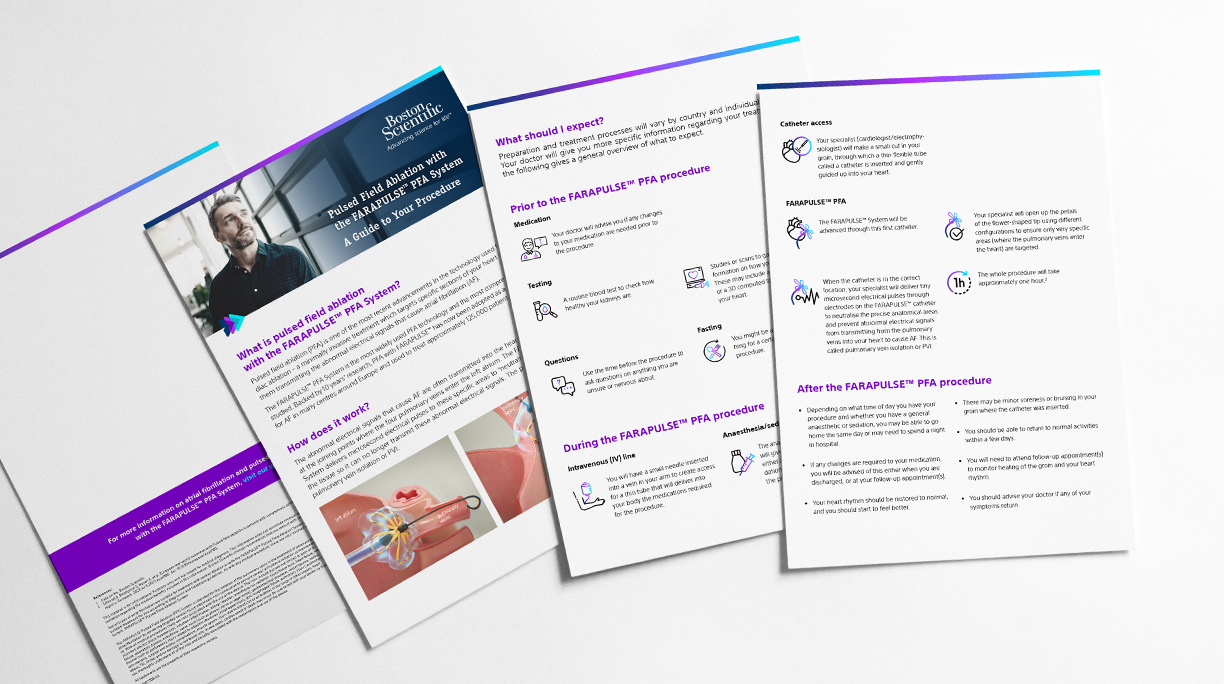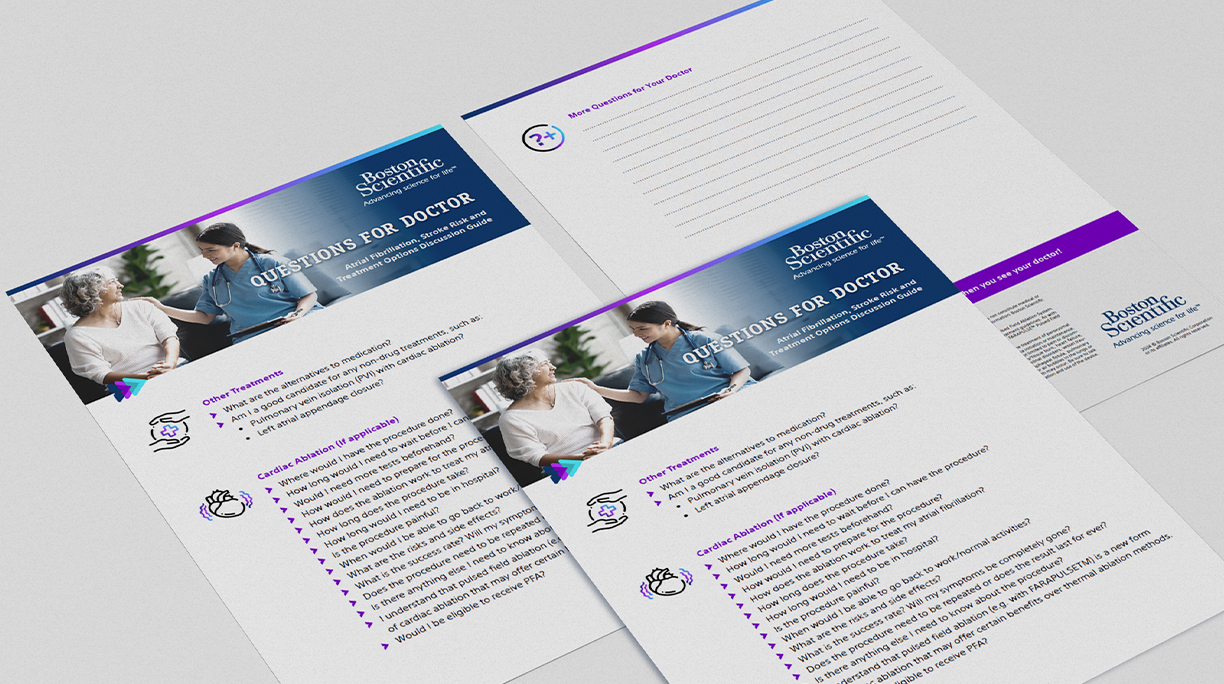Nothing is more important than your health and it’s normal to have lots of questions when you receive a diagnosis of a condition such as atrial fibrillation. It’s not always easy to think of everything you want to ask when you are sitting across from your doctor, so here is a list of questions for you to download and review before your next appointment – select those that you would like to talk to your doctor about and add any of your own. We’ve also listed and answered here some of the most common general questions people ask about atrial fibrillation and its treatment.
Questions about atrial fibrillation (AF)
Atrial fibrillation occurs when abnormal electrical signals disrupt your regular heartbeat –your heart loses its rhythm and starts to beat irregularly or too fast. This reduces your heart’s ability to pump blood efficiently around your body. Read more about atrial fibrillation here.
Symptoms of atrial fibrillation vary from person to person but most commonly include:
- Irregular heartbeat (palpitations, pounding or racing)
- Shortness of breath
- Tiredness or a general feeling of being unwell
- Chest discomfort or pain
- Dizziness or fainting
Some people with atrial fibrillation do not experience any symptoms. In ‘silent’ cases like this, atrial fibrillation might be picked up in a standard health check or when looking at another health issue.
The risk of atrial fibrillation increases with age and can be caused by a variety of factors that can cause damage to the heart. These include:
- High blood pressure
- Existing heart conditions, such as:
− Coronary artery disease (narrowed or blocked arteries)
− Previous heart attack or heart surgery
− Faulty heart valves
− Congenital (inherited) heart defect
− A problem with the natural pacemaker in the heart (the sinoatrial node) - Type 2 diabetes
- Overactive thyroid gland
- Sleep apnoea (when your breathing stops and starts while you are asleep)
- Lifestyle factors, including:
- Obesity (being overweight)
- Excessive alcohol consumption
- Physical inactivity
- Smoking
In some patients, atrial fibrillation occurs for no apparent cause.
In a healthy heart, organised pathways of electrical signals produce a steady rhythm, so your heart contracts to pump blood from the top to the bottom of the heart and then around the body. These regular beats are controlled by the sinoatrial (SA) node, which acts as the heart's natural pacemaker. During atrial fibrillation, abnormal signals completely disrupt the organised pathways and the controlled pace of your heartbeat. These disruptive signals are often initiated outside the heart but get transmitted into the left atrium of the heart via the pulmonary veins.
The most serious risk associated with atrial fibrillation is an up to 5x increased risk of stroke.2, 4 A stroke might occur due to a blood clot that travels to the brain. Stroke is a medical emergency which can cause long-term damage to your health, or even death.
Because atrial fibrillation reduces your heart's ability to pump as it should, blood may not be cleared out of the heart efficiently. If blood is not kept moving by the circulation process, there is a risk of it pooling and stagnating − most often in a part of the heart called the left atrial appendage (LAA). This blood has the potential to form a blood clot, which could then be pumped out of the heart and travel to the brain, causing a stroke.
If you experience any of the following symptoms, even if they seem mild, it is advisable to seek medical attention immediately:
- Weakness, numbness, or paralysis in one side of your body (particularly in face, arms, or legs)
- Difficulty in speaking or in understanding speech
- Dizziness or loss of balance or coordination
- Fainting or loss of consciousness
- Severe headache
A variety of treatment options are available for atrial fibrillation. Some treatments focus on managing your heartbeat's rhythm (regularity) and rate (pace), while others focus on the managing the risk of stroke. Your doctor will recommend you a tailored treatment that fits your specific condition. Read more about treatment options for atrial fibrillation here.
Following a healthy lifestyle can have a positive impact on the health of your heart and reduce your risk of stroke1, 2:
- Eat a healthy diet and maintain a healthy weight
- Exercise regularly
- Stop smoking
- Restrict/eliminate alcohol and caffeine
For more information on what you can do to improve your heart health and overall well-being, download our guide to healthy living here.
Questions about the treatment of atrial fibrillation
A variety of treatment options are available for atrial fibrillation:
- Short-term treatments to restore a regular heart rhythm, such as cardioversion.
- Longer-term treatments to restore and maintain a healthy heart rate and rhythm, including:
- Drug therapy
- Cardiac ablation - Treatments that focus on reducing the risk of stroke:
- Drug therapy
- Left atrial appendage closure (LAAC) which involves preventing blood entering the left atrial appendage which is where blood can pool and clot if your heart is not pumping efficiently.
Read more about the treatment options for atrial fibrillation here.
Read more about LAAC with WATCHMAN™ FLX here.
The European Society of Cardiology (ESC) has published Patient Guidelines on Atrial Fibrillation alongside the 2024 ESC Guidelines for Health Care Professionals to summarize all a patient needs to know about atrial fibrillation. Find out the ESC Patient Guidelines .
Cardiac ablation deactivates or "neutralises" locations in the heart responsible for transmitting the abnormal electrical signals that cause atrial fibrillation. Unlike heart surgery, it's a minimally invasive procedure performed by inserting long thin tubes called catheters through a small incision in your groin and advancing them through your blood vessels into your heart. Your specialist (cardiologist or electrophysiologist) monitors on screens the precise position of the catheters inside your vessels and your heart. Once in position, energy is delivered through a catheter to neutralise the target cardiac tissue, so it can no longer transmit electrical signals.
More recent treatment guidelines (which review latest clinical evidence to make their recommendations) include an increased number of categories of atrial fibrillation patient who might benefit from cardiac ablation.3
Cardiac ablation relies on energy being delivered to the target tissue to neutralise it. This energy can be:
- Thermal (temperature-based):
- Radiofrequency ablation (RFA) uses extreme heat
- Cryoablation uses extreme cold - Pulsed field ablation (PFA) represents a cutting-edge development in ablation technology and uses a non-thermal ablation method in the form of microsecond high-energy electrical pulses to neutralise the target tissue. Because cardiac cells are more sensitive to this electrical field than cells from other tissue, surrounding structures, such as the oesophagus or the phrenic nerve, usually will not be affected.4-8
The distinctive flower-shaped FARAPULSE™ Pulsed Field Ablation System is the first PFA system, introduced in 2021, and broadly studied.4-8
Questions about FARAPULSE™ Pulsed Field Ablation System
There are different types of atrial fibrillation (AF) and different types of cardiac ablation. Your doctor will assess your case to determine if cardiac ablation with the FARAPULSE™ PFA System is an appropriate treatment for you. Their assessment will consider the following:
The FARAPULSE™ PFA System may be right for you if:
- You suffer from paroxysmal atrial fibrillation (Atrial fibrillation episodes come and go, often resolving without treatment)
- You meet the criteria for a cardiac ablation procedure called pulmonary vein isolation (PVI)
The FARAPULSE™ PFA System is not right for you if:
- You suffer from persistent or permanent atrial fibrillation
- You do not meet the criteria for a PVI cardiac ablation procedure
As with any medical procedure, there are risks involved with pulsed field ablation with the FARAPULSE™ PFA System. See the Important Safety Information below for a list of possible complications, and ask your doctor about the risks and benefits of the FARAPULSE™ PFA System.
The electrical signals that cause atrial fibrillation are often transmitted into the heart via the tissue at the connection points between the pulmonary veins and the left atrium. Pulmonary vein isolation (PVI) is a cardiac ablation procedure with the goal of blocking transmission of these signals by targeting and neutralising the tissue at these specific connection points. By doing so, PVI helps prevent atrial fibrillation episodes from occurring.
For many people, ablation can eliminate or significantly reduce the symptoms and risks associated with atrial fibrillation, allowing them to return to normal activities with an improved quality of life. However, atrial fibrillation is a chronic disease, and while ablation can modify its progression, it is not always a permanent cure. While many patients experience long-term relief, some may still have episodes of atrial fibrillation and might need additional treatments or medications. Your doctor will monitor your progress and work with you to manage your condition effectively.
- Cardiac cells are more sensitive than other tissue to the pulsed, high-energy electrical fields created by the FARAPULSE™ PFA System, so surrounding structures to your heart, such as the oesophagus or the phrenic nerve, are better protected than when thermal energy is used8
- Extensive studies have shown PFA with FARAPULSE™ to be generally safe, with minimal side effects4-9
- Patients report minimal pain and fast recovery after their FARAPULSE™ PFA procedure10
- A study has shown that patients who underwent FARAPULSE™ PFA ablation had a significant improvement in quality of life.11
- Extensive studies have shown PFA with FARAPULSE™ to be generally safe, with minimal side effects.4-9
- The ADVENT clinical trial compared traditional thermal ablation to pulsed field ablation (PFA) for treating atrial fibrillation and found that PFA is just as effective and safe.8
- A separate study has shown that patients that underwent FARAPULSE™ PFA ablation had a significant improvement in quality of life.10
- The Farapulse™ Pulsed Field Ablation System is backed by over 10 years' research and has been used to treat >125,000 atrial fibrillation patients around the world.12
Visit Treatment with the FARAPULSE™ PFA System to learn what to expect before, during and after your PFA procedure, and to view an animation of how the procedure is performed. You can also download a PDF.
The FARAPULSETM Pulsed Field Ablation System was the first PFA system, introduced in 2021, and already used in many centers in Europe.11 If you and your doctor agree that that PFA with the FARAPULSE™ System is the right treatment for you, talk to them about which centre they will refer you to. You can search treatment centres that offer PFA with FARAPULSE™ here.



